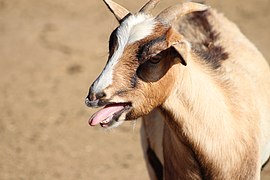Rabat Zoo
| Rabat Zoo | |
|---|---|
| حَدِيْقَة ٱلْحَيْوَانَات بِٱلرِّبَاط (in Arabic) Arabic: ٱلْحَدِيْقَة ٱلْوَطَنِيَّة لِلْحَيْوَانَات بِٱلرِّبَاط (in Arabic) Jardine Zoologique de Rabat (in French) | |
 A couple of lions at the zoo | |
 | |
| 33°57′11″N 6°53′42″W / 33.953°N 6.895°W | |
| Location | Rabat, Morocco |
| Website | rabatzoo |
Rabat Zoo (Arabic: حَدِيْقَة ٱلْحَيْوَانَات بِٱلرِّبَاط, romanized: Ḥadīqat al-Ḥaywānāt bir-Ribāṭ ("Zoological Garden in Rabat"), ٱلْحَدِيْقَة ٱلْوَطَنِيَّة لِلْحَيْوَانَات بِٱلرِّبَاط ("The National Park for Animals in Rabat"); French: Jardin Zoologique de Rabat), also known as "Temara Zoo", is a zoological park near Rabat in Morocco that was established in 1973. The first enclosures were built to house lions that were previously kept in the royal palace.[1] These lions were thought to be descendants from Barbary lions.[2]
Conservation[edit]
The zoo works to establish viable populations of endangered animals in the long term, allowing for the strengthening of the animal collection and, consequently, the reintroduction of certain groups into their original natural habitats. It reportedly houses over 1,800 animals representing nearly 180 species and works on more than 22 conservation programs for rare and endangered endemic species. Eight of these species are the subject of a reintroduction program to reintegrate them into their natural habitat, including five species extinct in the wild in Morocco.[3]
In the first quarter of 2024, more than 70 animals of Moroccan and African endemic species were reportedly born at the zoo. In a statement, the zoo indicated that "these species are classified by the International Union for Conservation of Nature (IUCN) as endangered, critically endangered as is the case for the addax, or endangered for the bald ibis, or vulnerable such as the Barbary sheep and Dorcas gazelles."[3]
Lions[edit]
Given that the Barbary lion is extinct in the wilderness, importance has been given to finding possible Barbary lions or descendants of the Barbary lion in captivity. So far, tests indicate the lions of the zoo are not pure Barbary lions, but descendants of the original Barbary lion.[4][5] This is partly as members of the Moroccan royal family had kept lions that were captured from the Atlas Mountains.[1]
Gallery[edit]
See also[edit]
References[edit]
- ^ a b Yamaguchi, N.; Haddane, B. (2002). "The North African Barbary Lion and the Atlas Lion Project". International Zoo News. 49 (8): 465–481.
- ^ Nowell, K.; Jackson, P. (1996). "Wild Cats of Africa" (PDF). Wild Cats: status survey and conservation action plan. IUCN/SSC Cat Specialist Group, Gland, Switzerland. pp. Plate I.
- ^ a b Jazouli, Zineb (2024-05-21). "Zoo de Rabat : Plus de 70 naissances d'espèces menacées en trois mois". Hespress Français - Actualités du Maroc (in French). Retrieved 2024-05-26.
- ^ Burger, J.; Hemmer, H. (2006). "Urgent call for further breeding of the relic zoo population of the critically endangered Barbary lion (Panthera leo leo Linnaeus 1758)" (PDF). European Journal of Wildlife Research. 52: 54–58. doi:10.1007/s10344-005-0009-z. S2CID 30407194. Archived from the original (PDF) on 3 July 2007.
- ^ Black, S.; Yamaguchi, N.; Harland, A.; Groombridge, J. (2010). "Maintaining the genetic health of putative Barbary lions in captivity: an analysis of Moroccan Royal Lions". European Journal of Wildlife Research. 56: 21–31. doi:10.1007/s10344-009-0280-5. S2CID 44941372.
External links[edit]
- Zoo Rabat, capital of Morocco YouTube
- Moroccan zoo is home to last of Atlas lions (allegedly)
- Parc Zoologique National ( Temara - Rabat ) - (2/2) الحديقة الوطنية للحيوانات (in Arabic





